Many people associate summer with festivals in Japan. From fireworks festivals, Tanabata festivals to Bon Odori, there are numerous matsuri (festivals) held during summer in Japan. In this article, we introduce the classic food & drinks, stalls, clothing and games you can expect at a typical Natsumatsuri.
Table of Contents
- What is Natsumatsuri (夏祭り)?
- What kind of Natsumatsuri are there in Japan?
- What is Yatai (屋台)? What kind of Yatai are there at Japanese summer festivals?
- What to wear to Natsumatsuri?
- Japanese Songs that Remind You of Natsumatsuri
What is Natsumatsuri (夏祭り)?

Natsumatsuri (夏祭り) is “summer festival” - 夏 (natsu) meaning summer, and 祭り (matsuri) meaning festival.
The origin of the word 祭り is from 祭る (matsuru), that means to pray or to worship, and to deify or to enshrine. It has always had a strong connection with the Gods. In Japan, there are many festivals that are celebrated that have strong connections to deities, for example to pray for good harvest. These festivals are usually named by “purpose of festival” + 「祭」, eg. 収穫祭 (shuukaku-sai) - harvest festival, 新年祭 (shinnen-sai) - new year festival, and 慰霊祭 (irei-sai) - memorial service. Notice that when used this way, the Kanji「祭」is read “sai”.
Not just summer festival (夏祭り), there are festivals for each season - 春祭り (harumatsuri) - spring festival, 秋祭り (akimatsuri) - autumn festival, and 冬祭り (fuyumatsuri). Yet, natsumatsuri stands out the most among them all and has the most events.
It is said that the Japanese culture of natsumatsuri started during the Edo period. Originally, they were held to pray for protection from summer epidemics and to honour the dead. While in rural and agricultural areas, they were held to relieve the fatigue of summer farming. As we enter the modern period, natsumatsuri has become a joyful event to enjoy with family, relatives and acquaintances. As well as to beat the summer heat.
Writer's Pick
What kind of Natsumatsuri are there in Japan?
There are many types of Natsumatsuri, aka Japanese summer festivals, to enjoy in Japan. Here, we introduce some of them.
Tanabata Festival (七夕祭り)

Tanabata Matsuri, Tanabata Festival or the Star Festival all refer to the same celebration. Tanabata (七夕) actually refers to the “night of the 7th day of the 7th month of the lunar calendar”. After Japan adopted the Gregorian calendar, Tanabata was set on July 7th, but there are still many places in Japan that choose to celebrate and hold their festivals in August which is closer to the lunar calendar date.
Tanabata Festivals in Japan are characterised by writing wishes on paper strips, colourful Tanabata decorations, eating soumen, and sharing the legend of Orihime and Hikoboshi - the story that started it all.
Fireworks Festival (花火大会)

Fireworks (花火 hanabi) are often associated with summer festivals. There are handheld sparklers that people play at the beach or behind their house, and huge ones that are launched into the sky - 打ち上げ花火 (uchiage hanabi).
Fireworks festivals, called hanabi-taikai (花火大会) in Japanese, are one of the most anticipated summer events. Particularly famous ones, like the Sumidagawa Fireworks Festival in Tokyo, draw people from all over Japan and even overseas. There are also fireworks competitions that double as festivals.
Bon Odori (盆踊り)

Obon (お盆) is a Japanese event to celebrate and honour the spirits of the deceased. There is a belief that during the Obon period, ancestral spirits temporarily return to this realm to visit loved ones. There are many customs associated with Obon, and Bon Odori is one of them.
”It is said that the Japanese culture of natsumatsuri started during the Edo period. Originally, they were held to pray for protection from summer epidemics and to honour the dead.”
Remember we said this earlier on? Well, Bon Odori is the natsumatsuri for honouring the dead.
Bon Odori (盆踊り) is a traditional Japanese folk dance that is performed at Obon Festivals. Different regions in Japan have different styles of Bon Odori, for example Awa Odori and Gujo Odori. Originally, they were performed to welcome the spirits, and to send them off at the end of Obon. Nowadays, Bon Odori is a classic summer festival with the image of people dancing around a tall turret.
Float Festival (山車祭り)
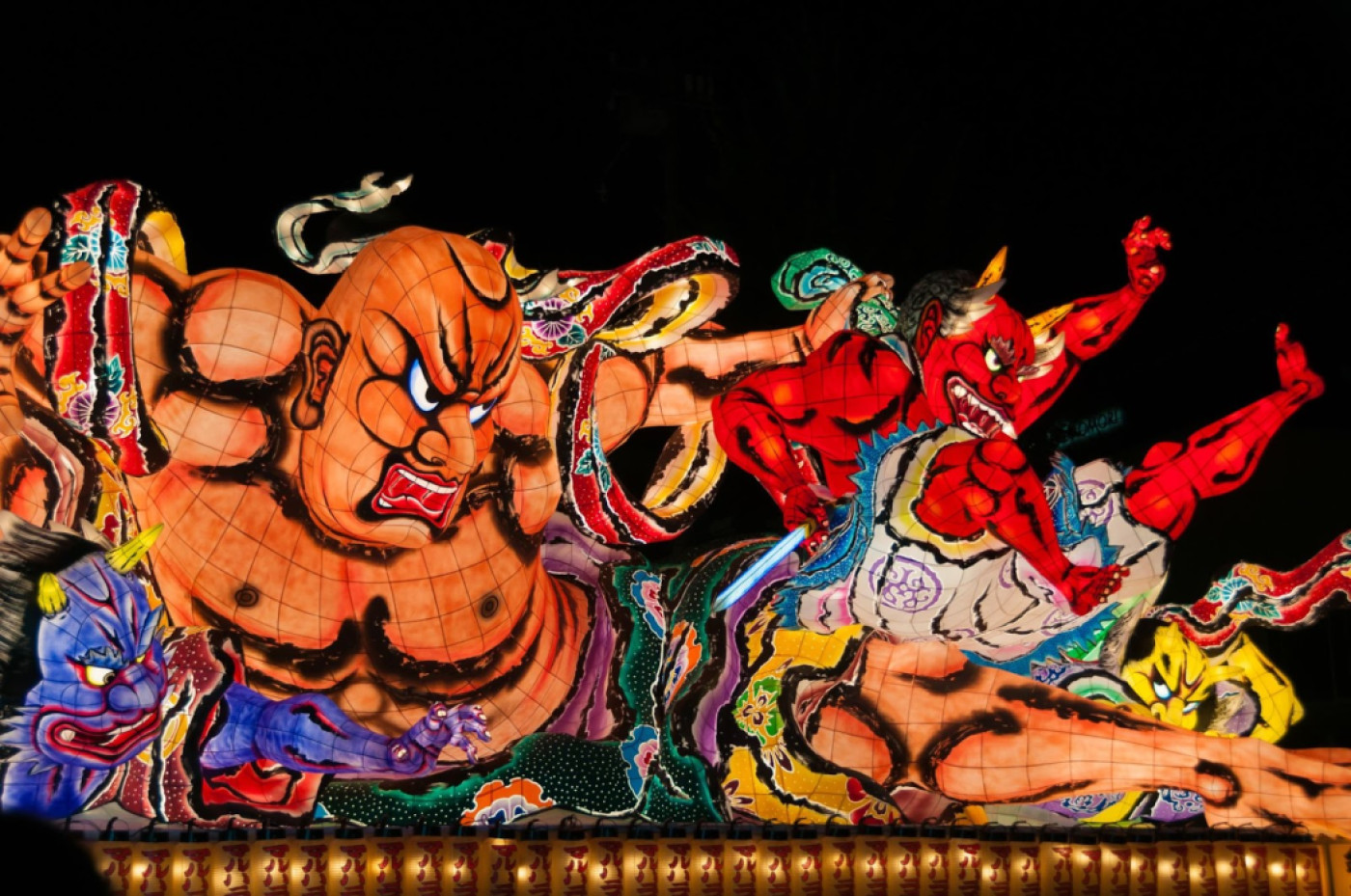
There are also natsumatsuri that feature floats decorated with dolls, flowers, and other extravagant ornaments. These giant floats are the highlight of float festivals (山車祭り dashimatsuri), and are pulled or carried by people through the streets.
A popular festival with floats is the Aomori Nebuta Festival. The sight of the large illuminated floats moving down the streets is a powerful sight to behold. Another popular festival is the Gion Festival in Kyoto Prefecture. The highlight of the festival is the Yamaboko (山鉾) floats with their dolls and intricate designs.
Shrine Festivals
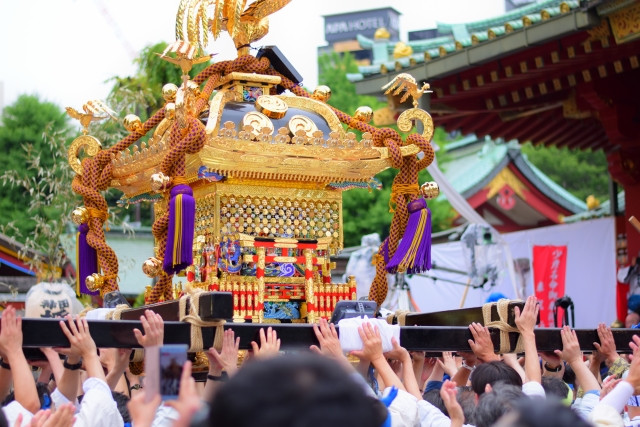
Natsumatsuri also consists of shrine festivals. The highlight of shrine festivals is the “mikoshi procession”. Mikoshi (神輿) is a portable shrine that is carried through the streets during a festival. It is believed that the portable shrine carries the body and spirit of a deity.
Mikoshi processions have long been held in Japan following the traditional belief that good things, such as happiness, good health, business prosperity, and good harvest will come to the places where the mikoshi passes through. A representative of shrine festivals is Sanja Matsuri that is held by Asakusa Shrine in Tokyo.
What is Yatai (屋台)? What kind of Yatai are there at Japanese summer festivals?

Yatai (屋台) means “stall”. A natsumatsuri isn’t complete without different types of stalls selling food, drinks, and more. So, what type of stalls can you expect to see at a typical Japanese summer festival?
Food, Drinks and Dessert Stalls
Food is a huge part of Natsumatsuri. There are people who attend just for the food! Among the many festival foods there, we will introduce to you the 定番 (teiban) - standard classic ones.
Yakisoba 焼きそば
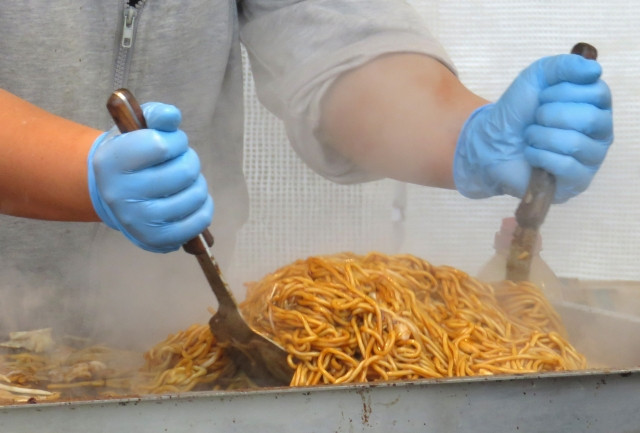
Yakisoba sizzling on a large iron plate tempts festival guests with its appetising smell and colour. You can get yakisoba anywhere anytime, but somehow it’s a must to have at a festival! Even among Japanese people, it is said that yakisoba from a yatai at a festival is somehow more delicious! Maybe it’s the mood and atmosphere?
Takoyaki たこ焼き
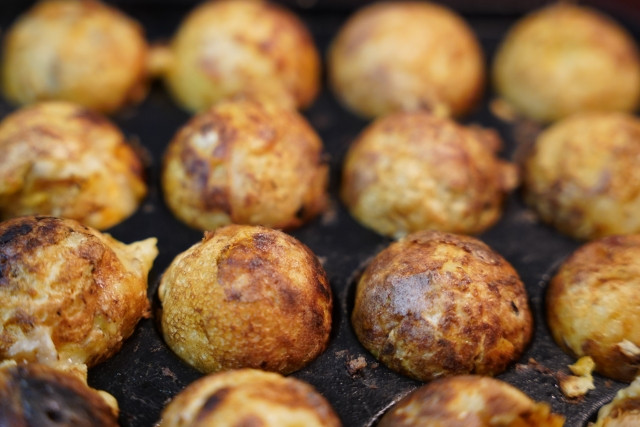
Takoyaki, aka “octopus balls”, are another staple yatai at natsumatsuri. Piping hot freshly made takoyaki tastes even better eaten under the evening / night sky. When people inevitably burn their mouths, you can hear them exclaim 「あちっ!」(achi) - hot !
Okonomiyaki お好み焼き
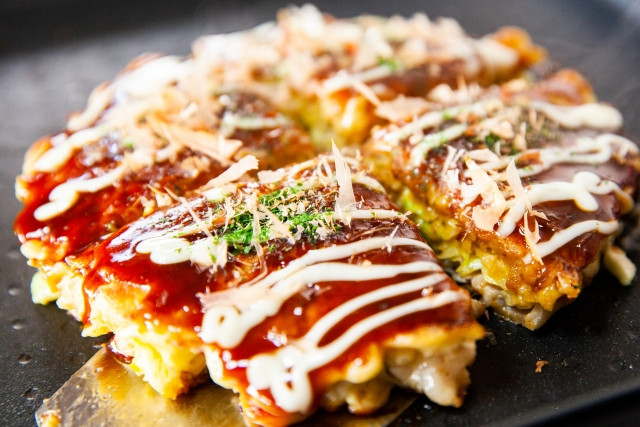
Okonomiyaki is a savoury “pancake” that is famous in Osaka and Hiroshima. You can find both styles of okonomiyaki at matsuri yatai. What’s the difference between them? Hiroshima-style okonomiyaki has noodles and is topped with a fried egg.
Candy Apple (りんご飴 / ringo ame)

A sweet made by coating whole apples in sugar syrup. It’s quite hard to hold and eat as it is held up on a stick and the apple can be quite heavy. People eat it in different ways, such as working through the sweet treat slowly, or licking off the sugar before starting on the apple.
Grilled Squid (イカ焼き / ikayaki)

Grilled squid! Some stalls sell whole squids, while some sell them separated by their parts - head and tentacles. Juicy, chewy and savoury, it goes really well with cold drinks and beer!
Kakigori かき氷
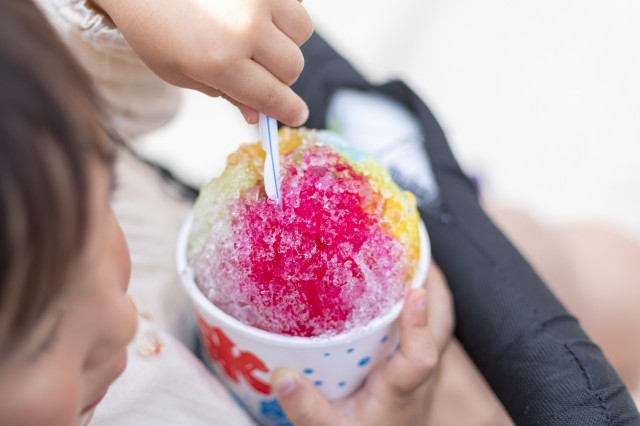
Shaved ice is a staple summer dessert. Finely shaved ice is topped with flavoured syrup. There are many syrup flavours like strawberry, melon, lemon, blue hawaii (tastes like ramune), apple, and more. The syrup’s bright colours go very well with summer nights, reminiscent of fireworks in the sky!
Cotton Candy (綿飴 / wataame)
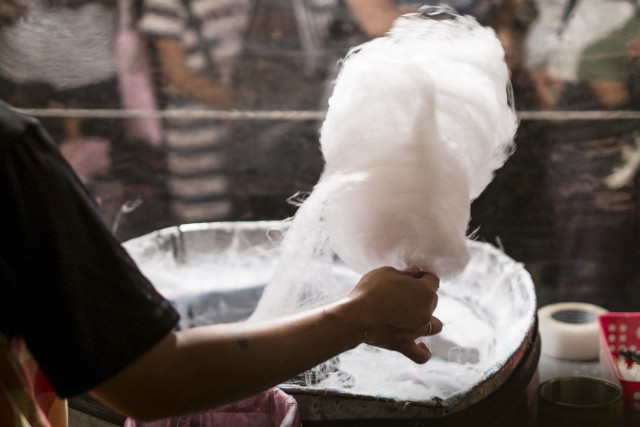
Fluffy and sweet cotton candy that melts on your tongue! Comes in different flavours and colours. There are stalls that make classic looking cotton candy on a stick, cotton candy in a bag (some with cute designs like Pokemon), and fancy cotton candy made into shapes like flowers.
Choco Banana チョコバナナ
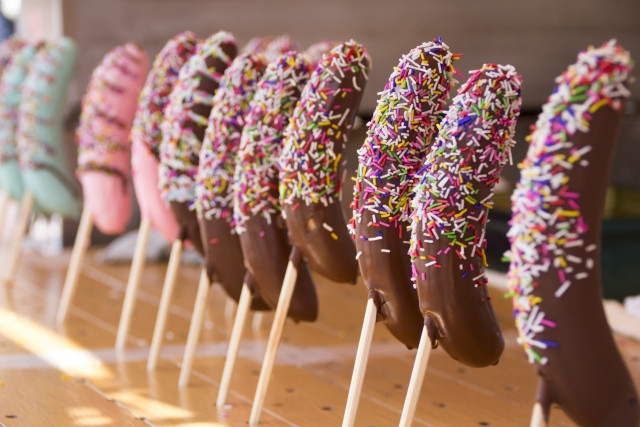
Chocolate coated rainbow sprinkled banana on a stick. Incredibly simple to make at home, yet somehow a popular and unmissable dessert snack at Japanese summer festivals. Maybe it’s because bananas are great for restoring energy? More energy = more hype for the festival.
Baby Castella ベビーカステラ
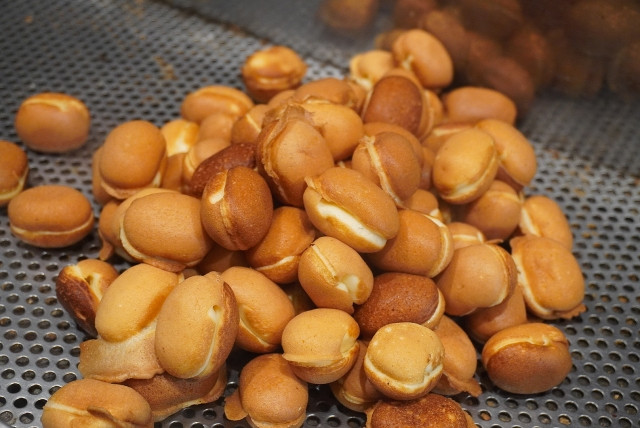
Baby Castellas are castellas (a type of traditional Japanese confectionery) cooked in a round ball form using a special pan. With quick hand motions, the cook expertly flicks the baby castellas out of the pan when they are cooked. They are prettily golden-browned on the outside, and soft and fluffy on the inside.
Ramune ラムネ
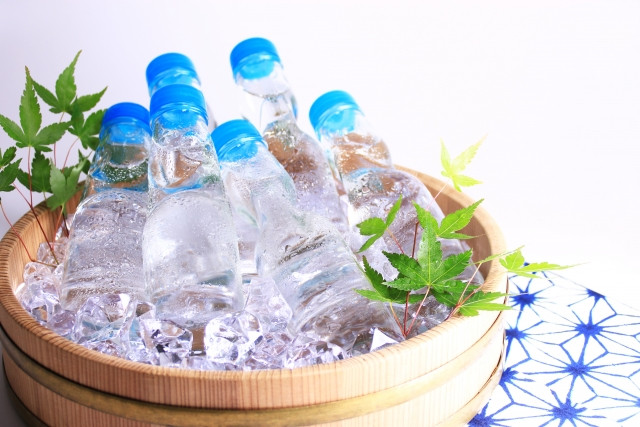
You can also find drink stalls at matsuri, usually serving beer and soft drinks. Among these, the classic summer and natsumatsuri drink is of course ramune! Ramune is a carbonated soft drink sold in a special bottle. To drink, you need to push the marble down where it is caught in a trap. It's fun to try to get the marble out.
Game Stalls
Matsuri also has stalls for entertainment! Have you seen “goldfish scooping” in anime and Japanese movies and dramas? There are also other games that are iconic of matsuri in Japan.
Goldfish Scooping (金魚すくい / kingyosuki)
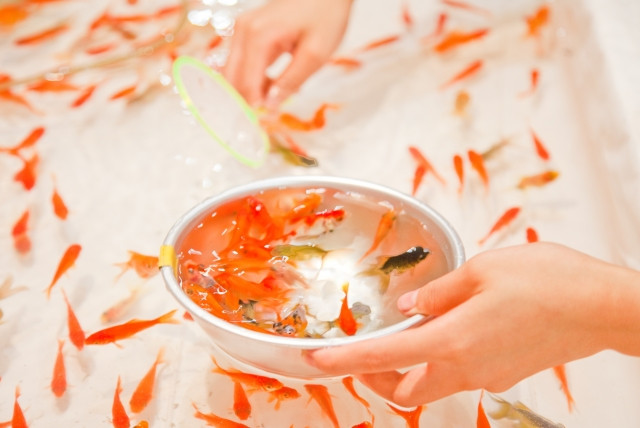
Goldfish Scooping is a game where you use a tool called「ぽい」(poi) to catch goldfish. The “poi” is a thin net made by applying a thin sheet of paper on a round frame with a handle attached. It is not easy as the paper dissolves easily in water. The game requires skill and carefulness. Bringing home the goldfish you caught is one of the pleasures of goldfish scooping.
Superball Scooping (スーパーボールすくい / suupaa-booru-sukui)

Superball Scooping is a similar game to Goldfish Scooping. A poi is also used but this time to scoop the small balls. It is not as simple as it looks as the balls are quite heavy which will break the poi. There are cases where the balls just float on the water surface, or cases where they swirl around in the tank. Scoop up the balls you like and bring them home with you.
Yo-yo Fishing (ヨーヨー釣り / yooyoo-tsuri)
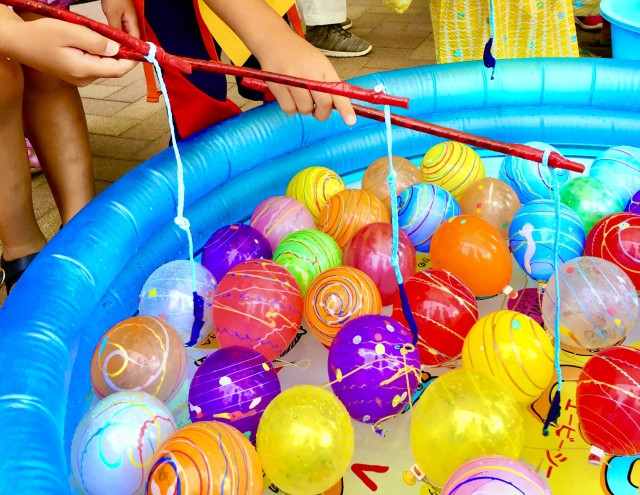
Yo-yo fishing is a game where you “fish” small water balloons floating in a tank. The game requires precision and patience to hook up the balloons from their tiny rings. You also get to keep the balloon you catch - you can see people walking around with them.
Shooting Range (射的 / shateki)
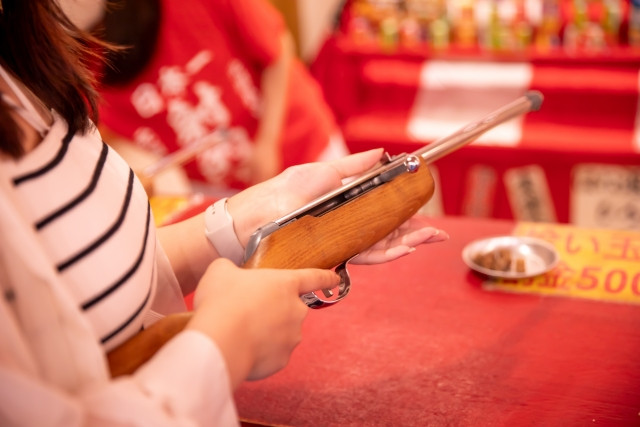
A game in which you use a toy gun to shoot down targets or prizes lined up on shelves. If you shoot down a prize, you get to keep it. Or, if you shoot enough targets and get enough points, you can exchange points for a prize.
Ring Toss (輪投げ / wanage)

Ring toss is a game where you throw rings onto poles from a distance. The more poles you manage to get rings onto, the more points you get which you can use to exchange for prizes. At festival stalls, toys are often placed instead of poles, and you can receive the object caught by your ring. It is a popular game for children because it is easy to play.
Masks and Items Stalls
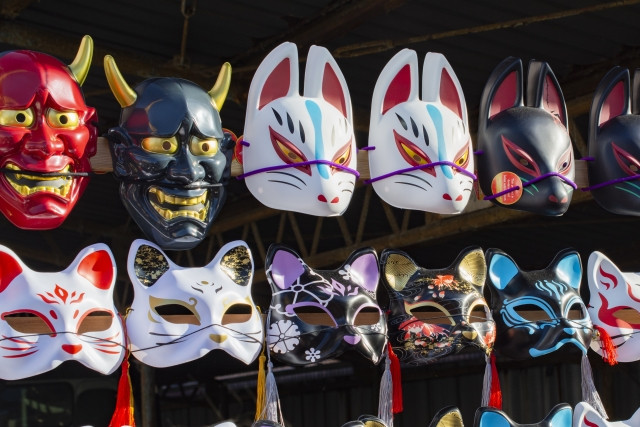
Yatai selling masks and glowing items are another staple at natsumatsuri. You can find Japanese masks such as “hyottoko (ひょっとこ)” and okame (おかめ), as well as anime characters masks. Glowing bracelets and headbands are also popular with children and adults.
What to wear to Natsumatsuri?
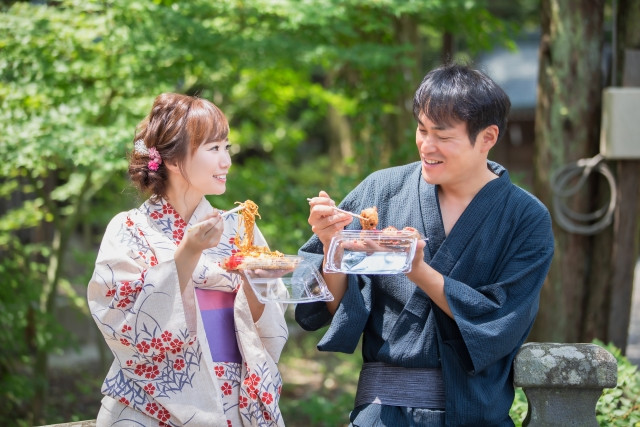
Yukata, jinbei, and happi are the standard traditional Japanese clothing to wear to natsumatsuri.
Yukata (浴衣), which is a kimono for summer, has sleeves and hem that allow wind to pass through and hot air to escape. Kimono fabric patterns for summer include all types of flowers, goldfish, and fireworks.
Jinbei (甚平) is a casual summer wear mainly worn by men and children, but they have them for women now. Consisting of a short sleeved top and shorts, its loose fit helps keep you cool in the hot summer.
Happi (半被) is an outer coat with a shop name or family crest printed on it. Happi is usually worn by those participating in the festival as yatai vendors or performers - people who form a team to pull the floats, festival dancers, festival staff, music performers such as taiko drummers, etc.
Of course, you can also choose to wear everyday plain clothing.
Japanese Songs that Remind You of Natsumatsuri
Considering how big natsumatsuri is as a part of Japanese culture, it only makes sense that there are songs about summer festivals. Among them, the classic summer festival song is “Natsumatsuri (夏祭り)” by JITTERIN’ JINN. First released in 1990, the song became a huge hit again in 2000 when covered by Whiteberry. Even in recent years, the song continues to be covered. It is even available to play on Taiko no Tatsujin.
Another popular natsumatsuri song is “Uchiage Hanabi (打ち上げ花火)” by DAOKO x Kenshi Yonezu that has become the second classic summer festival song.
Other natsumatsuri or fireworks festival themed songs include:
- Watagashi (わたがし) by back number (↑)
- HANABI by Mr. Children (Youtube Link)
- Hanabi (花火) by aiko (Youtube Link)
- Nagaku Michigai Matsuri (長く短い祭り)bby Ringo Sheena (Youtube Link)
- H・A・N・A・B・I ~ kimi ga ita natsu ~ (〜君がいた夏〜」) by ZONE (Youtube Link)
- Kaze ni Kaoru Natsu no Kioku (風に薫る夏の記憶) by AAA (Youtube Link)
- Natsu no Oto (夏の音) by GReeeeN (Youtube Link)
- Ano Yume o Nazotte (あの夢をなぞって) by YOASOBI (Youtube Link)
and many more.

.jpg)








.jpg)

.jpg)







 (2).png)














